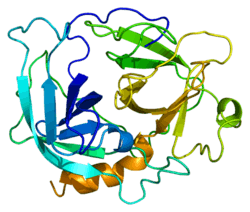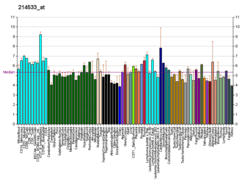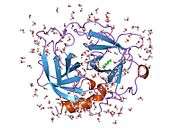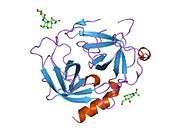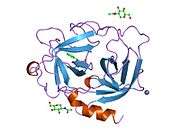CMA1
Chymase is an enzyme that in humans is encoded by the CMA1 gene.[5]
This gene product is a chymotryptic serine proteinase that belongs to the peptidase family S1. It is expressed in mast cells and thought to function in the degradation of the extracellular matrix, the regulation of submucosal gland secretion, and the generation of vasoactive peptides. In the heart and blood vessels, this protein, rather than angiotensin converting enzyme, is largely responsible for converting angiotensin I to the vasoactive peptide angiotensin II. Angiotensin II has been implicated in blood pressure control and in the pathogenesis of hypertension, cardiac hypertrophy, and heart failure. Thus, this gene product is a target for cardiovascular disease therapies. This gene maps to 14q11.2 in a cluster of genes encoding other proteases.[6]
References
- GRCh38: Ensembl release 89: ENSG00000092009 - Ensembl, May 2017
- GRCm38: Ensembl release 89: ENSMUSG00000022225 - Ensembl, May 2017
- "Human PubMed Reference:". National Center for Biotechnology Information, U.S. National Library of Medicine.
- "Mouse PubMed Reference:". National Center for Biotechnology Information, U.S. National Library of Medicine.
- Caughey GH, Schaumberg TH, Zerweck EH, Butterfield JH, Hanson RD, Silverman GA, Ley TJ (May 1993). "The human mast cell chymase gene (CMA1): mapping to the cathepsin G/granzyme gene cluster and lineage-restricted expression". Genomics. 15 (3): 614–20. doi:10.1006/geno.1993.1115. PMID 8468056.
- "Entrez Gene: CMA1 chymase 1, mast cell".
Further reading
- Urata H, Nishimura H, Ganten D (1996). "Chymase-dependent angiotensin II forming systems in humans". Am. J. Hypertens. 9 (3): 277–84. doi:10.1016/0895-7061(95)00349-5. PMID 8695029.
- Takai S, Miyazaki M (2003). "Effect of chymase inhibitor on vascular proliferation". Jpn. J. Pharmacol. 90 (3): 223–7. doi:10.1254/jjp.90.223. PMID 12499576.
- Urata H, Kinoshita A, Perez DM, et al. (1991). "Cloning of the gene and cDNA for human heart chymase". J. Biol. Chem. 266 (26): 17173–9. PMID 1894611.
- Jenne DE, Tschopp J (1991). "Angiotensin II-forming heart chymase is a mast-cell-specific enzyme". Biochem. J. 276 (2): 567–8. doi:10.1042/bj2760567. PMC 1151130. PMID 2049082.
- Caughey GH, Zerweck EH, Vanderslice P (1991). "Structure, chromosomal assignment, and deduced amino acid sequence of a human gene for mast cell chymase". J. Biol. Chem. 266 (20): 12956–63. PMID 2071582.
- Urata H, Boehm KD, Philip A, et al. (1993). "Cellular localization and regional distribution of an angiotensin II-forming chymase in the heart" (PDF). J. Clin. Invest. 91 (4): 1269–81. doi:10.1172/JCI116325. PMC 288095. PMID 7682566.
- Saarinen J, Kalkkinen N, Welgus HG, Kovanen PT (1994). "Activation of human interstitial procollagenase through direct cleavage of the Leu83-Thr84 bond by mast cell chymase". J. Biol. Chem. 269 (27): 18134–40. PMID 8027075.
- Schechter NM, Wang ZM, Blacher RW, et al. (1994). "Determination of the primary structures of human skin chymase and cathepsin G from cutaneous mast cells of urticaria pigmentosa lesions". J. Immunol. 152 (8): 4062–9. PMID 8144971.
- Schechter NM, Jordan LM, James AM, et al. (1993). "Reaction of human chymase with reactive site variants of alpha 1-antichymotrypsin. Modulation of inhibitor versus substrate properties". J. Biol. Chem. 268 (31): 23626–33. PMID 8226889.
- Sukenaga Y, Kido H, Neki A, et al. (1993). "Purification and molecular cloning of chymase from human tonsils". FEBS Lett. 323 (1–2): 119–22. doi:10.1016/0014-5793(93)81461-8. PMID 8495723.
- Nakano A, Kishi F, Minami K, et al. (1997). "Selective conversion of big endothelins to tracheal smooth muscle-constricting 31-amino acid-length endothelins by chymase from human mast cells". J. Immunol. 159 (4): 1987–92. PMID 9257865.
- McGrath ME, Mirzadegan T, Schmidt BF (1998). "Crystal structure of phenylmethanesulfonyl fluoride-treated human chymase at 1.9 A". Biochemistry. 36 (47): 14318–24. doi:10.1021/bi971403n. PMID 9400368.
- Kishi F, Minami K, Okishima N, et al. (1998). "Novel 31-amino-acid-length endothelins cause constriction of vascular smooth muscle". Biochem. Biophys. Res. Commun. 248 (2): 387–90. doi:10.1006/bbrc.1998.8980. PMID 9675146.
- Pereira PJ, Wang ZM, Rubin H, et al. (1999). "The 2.2 A crystal structure of human chymase in complex with succinyl-Ala-Ala-Pro-Phe-chloromethylketone: structural explanation for its dipeptidyl carboxypeptidase specificity". J. Mol. Biol. 286 (1): 163–73. doi:10.1006/jmbi.1998.2462. PMID 9931257.
- Pereira PJ, Wang ZM, Rubin H, et al. (1999). "The 2.2 A Crystal Structure of Human Chymase in Complex with Succinyl-Ala-Ala-Pro-Phe-chloromethylketone: Structural Explanation for its Dipeptidyl Carboxypeptidase Specificity". Journal of Molecular Biology. 286 (4): 817. doi:10.1006/jmbi.1999.2691. PMID 10208809.
- de Paulis A, Minopoli G, Dal Piaz F, et al. (1999). "Novel autocrine and paracrine loops of the stem cell factor/chymase network". Int. Arch. Allergy Immunol. 118 (2–4): 422–5. doi:10.1159/000024153. PMID 10224464.
- Caughey GH, Raymond WW, Wolters PJ (2000). "Angiotensin II generation by mast cell alpha- and beta-chymases". Biochim. Biophys. Acta. 1480 (1–2): 245–57. doi:10.1016/S0167-4838(00)00076-5. PMID 10899625.
- Mellon MB, Frank BT, Fang KC (2002). "Mast cell alpha-chymase reduces IgE recognition of birch pollen profilin by cleaving antibody-binding epitopes". J. Immunol. 168 (1): 290–7. doi:10.4049/jimmunol.168.1.290. PMID 11751973.
External links
- Human CMA1 genome location and CMA1 gene details page in the UCSC Genome Browser.
